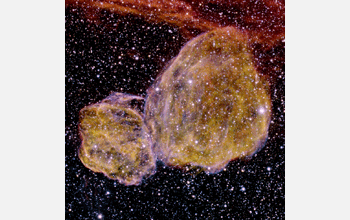Multimedia Gallery
Supernova Remnants
The Gemini South Multi-Object Spectrograph (GMOS) recently captured a dramatic image of a vast cloud complex named DEM L316, located in the Large Magellanic Cloud, a nearby galaxy. The peanut-shaped nebula appears to be a single object, but the latest research indicates that it is really comprised of two distinct gas and dust clouds formed by different types of supernova explosions.
The image reveals the intricate tendrils of gas and dust located in the remnants of the stellar explosions that created the still-expanding cloud complex. The object was first recognized in the early 1970s as a supernova remnant, a type of object that is enriched with elements created in stellar explosions. The nebula was likely created a few tens of thousands of years ago by more than one type of supernova exploding in the region of the Large Magellanic Cloud.
More about Gemini
The Gemini Observatory consists of twin eight-meter optical/infrared telescopes located on two of the best sites on our planet for observing the universe. Together, these telescopes can access the entire sky.
The Gemini South telescope is located at almost 9,000 feet on a mountain in the Chilean Andes called Cerro Pachon. The Frederick C. Gillett Gemini North Telescope is located on Hawaii's Mauna Kea, as part of the international community of observatories that have been built to take advantage of the superb atmospheric conditions on this long dormant volcano that rises almost 14,000 feet into the dry, stable air of the Pacific.
Gemini was built and is operated by a partnership of seven countries, including the United States, United Kingdom, Canada, Chile, Australia, Brazil and Argentina. Any astronomer in each partner country can apply for time on Gemini, which is allocated in accordance with the amount of financial support provided by each country. To learn more about Gemini, visit the observatory's website Here. (Date of Image: January 2008)
Credit: P. Michaud, S. Fisher and R. Carrasco, Gemini; T. rector, University of Alaska at Anchorage/Gemini Observatory
Special Restrictions: Please read the Gemini Observatory Image/Video Usage Policy before using this image.
Images and other media in the National Science Foundation Multimedia Gallery are available for use in print and electronic material by NSF employees, members of the media, university staff, teachers and the general public. All media in the gallery are intended for personal, educational and nonprofit/non-commercial use only.
Images credited to the National Science Foundation, a federal agency, are in the public domain. The images were created by employees of the United States Government as part of their official duties or prepared by contractors as "works for hire" for NSF. You may freely use NSF-credited images and, at your discretion, credit NSF with a "Courtesy: National Science Foundation" notation.
Additional information about general usage can be found in Conditions.
Also Available:
Download the high-resolution JPG version of the image. (976 KB)
Use your mouse to right-click (Mac users may need to Ctrl-click) the link above and choose the option that will save the file or target to your computer.

